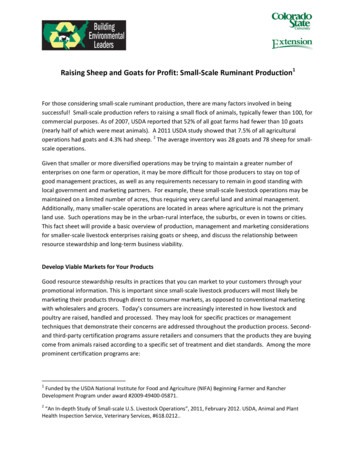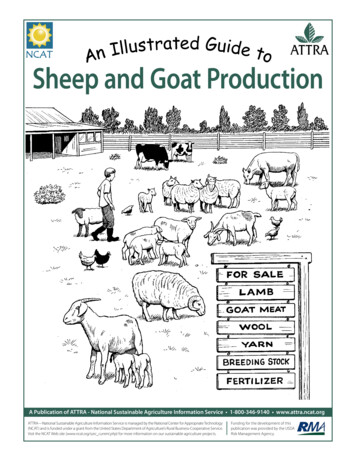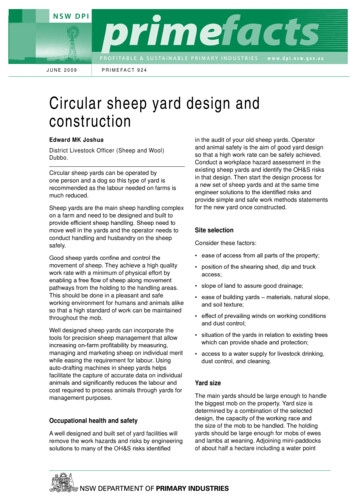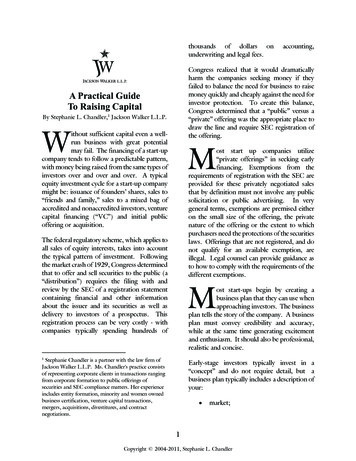
Transcription
Raising Sheep and Goats for Profit: Small‐Scale Ruminant Production1For those considering small‐scale ruminant production, there are many factors involved in beingsuccessful! Small‐scale production refers to raising a small flock of animals, typically fewer than 100, forcommercial purposes. As of 2007, USDA reported that 52% of all goat farms had fewer than 10 goats(nearly half of which were meat animals). A 2011 USDA study showed that 7.5% of all agriculturaloperations had goats and 4.3% had sheep. 2 The average inventory was 28 goats and 78 sheep for small‐scale operations.Given that smaller or more diversified operations may be trying to maintain a greater number ofenterprises on one farm or operation, it may be more difficult for those producers to stay on top ofgood management practices, as well as any requirements necessary to remain in good standing withlocal government and marketing partners. For example, these small‐scale livestock operations may bemaintained on a limited number of acres, thus requiring very careful land and animal management.Additionally, many smaller‐scale operations are located in areas where agriculture is not the primaryland use. Such operations may be in the urban‐rural interface, the suburbs, or even in towns or cities.This fact sheet will provide a basic overview of production, management and marketing considerationsfor smaller‐scale livestock enterprises raising goats or sheep, and discuss the relationship betweenresource stewardship and long‐term business viability.Develop Viable Markets for Your ProductsGood resource stewardship results in practices that you can market to your customers through yourpromotional information. This is important since small‐scale livestock producers will most likely bemarketing their products through direct to consumer markets, as opposed to conventional marketingwith wholesalers and grocers. Today’s consumers are increasingly interested in how livestock andpoultry are raised, handled and processed. They may look for specific practices or managementtechniques that demonstrate their concerns are addressed throughout the production process. Second‐and third‐party certification programs assure retailers and consumers that the products they are buyingcome from animals raised according to a specific set of treatment and diet standards. Among the moreprominent certification programs are:1Funded by the USDA National Institute for Food and Agriculture (NIFA) Beginning Farmer and RancherDevelopment Program under award #2009‐49400‐05871.2“An In‐depth Study of Small‐scale U.S. Livestock Operations”, 2011, February 2012. USDA, Animal and PlantHealth Inspection Service, Veterinary Services, #618.0212.
Animal Welfare ApprovedHumane Farm Animal Care (HFAC) Certified HumaneUSDA Certified OrganicGlobal Animal PartnershipFood AllianceAmerican Humane CertifiedAmerican Grassfed Association (AGA)Certified Naturally GrownIn addition, there are emerging opportunities in ethnic markets such as those designated as kosher(processed and prepared according to the customs and beliefs of the Jewish faith) and halal (processedand prepared according to the customs and beliefs of the Muslim faith). However, the demand forkosher and halal livestock products is often not aligned with the typical livestock production calendar oflater fall breeding (see this ethnic holiday calendar dar.html). Therefore, producing kids or lambs forspring holidays is easier than producing them for the winter holidays when you would be breeding youranimals in the late spring for a fall birth rather than in the late fall for winter birth (based on a five‐month gestation period). Targeting this market then implies appropriate housing for newborn kids andlambs that is warm and draft‐free for fall and winter births―investments that may be worthwhiledepending on the strength of those markets. In any case, market research is essential to ensuring thatyou have buyers for your products at the times they are ready for sale, and at the prices you anticipate,especially when considering specialty markets. For more information on conducting your own marketresearch, see: ductingmarketresearch.pdf.There are several issues livestock producers should consider when deciding whether to seekcertification, including: Benefits—Certification may offer producers opportunities to enter new markets (e.g. specialtyfood stores and restaurants) that require that their animal products be sourced from humanelyraised animals. Producers may also enjoy greater customer interest and loyalty or a premiumprice at farmers’ markets and CSAs. Goals—A producer should seek certification from a program whose goals and philosophy alignwith his/hers and will provide a benefit to the business. Retrofitting an operation or changing abusiness plan in a manner that is far from the current mission may cause unneeded stress andresult in a “bad fit” in the long‐run. The producer also should evaluate the feasibility ofmeeting the scope and stringency of certification program standards. Animals—Some programs, such as USDA Certified Organic, offer certification for virtually alldomestic livestock, while others, such as Global Animal Partnership, have developed standardsfor a more limited range of species. Standards—Certification program standards generally address animals’ living conditions,healthcare requirements, nutrition and water, access to the outdoors/pasture, prohibitions on2
animal alterations and animal transport and slaughter. However, not all areas are coveredexplicitly by all programs, and the stringency of standards can vary considerably acrossprograms. Certification Process—Generally, achieving certification includes the following steps:1. Reviewing program standards and fees and determining the feasibility ofimplementation of any required changes,2. Completing a formal application for certification,3. Audit of production practices by the certifying organization or a contracted third‐partyagency,4. Reviewing audit results by the certifying organization (in the case of a third‐party audit),5. If necessary, altering production practices deemed necessary post‐audit. Fee Structure—Most certifications require a combination of application, audit and annualcertification fees. Some fees may prove prohibitively expensive for small‐scale producers,although reduced pricing is available for some programs. Through the USDA’s Organic CostShare Program, for example, any certified producer or handler can apply for assistance andreceive a maximum of 750 per year and be reimbursed for up to 75% of annual certificationcosts. Although Animal Welfare Approved is a free program, it maintains stringent animalwelfare standards which will require additional management time to meet. Timeline—From the time of application, certification typically takes several weeks for mostprograms. However, the timeline may be extended significantly if changes to productionpractices are required or, in the case of the USDA Organic Program, if a farm has not beenemploying organic practices for three years. Production Costs—Producers may incur increases in production costs as a result of complyingwith animal welfare standards. Some of the more common sources of increased costs include:a.b.c.d.e.Larger pasture acreage requirement per animalIncreased non‐pasture feed costsAlterations or additions to animal facilitiesChanges to animal health care practicesMore extensive record‐keeping regarding animal history and production practicesFor more information on animal certification programs, s/Animal%20Certification%20Programs final 0.pdf. A finalconsideration in planning for meat or milk production is identifying how you will process the product fordirect to consumer markets. Such markets may include farmers’ markets, retail and wholesale buyers,restaurants and institutional buyers. Each buyer will have specific tastes and preferences for the productthey want to purchase, and milk and meats must be processed according to federal and stateregulations. Packaged meats must be processed in federally inspected facilities, and it is often3
challenging for small‐scale producers to find a processor who can work with a smaller volume ofproduct. For assistance in locating a meat processor, see http://www.nichemeatprocessing.org.Plan for Your Production and Your MarketsBefore marketing your product you should carefully research the small ruminant breeds available, andknow how you will raise and manage those animals.There are over 40 different sheep breeds in the U.S., so you need to determine which breed will bestmeet your marketing goals, production schedule, and climatic conditions for your production location.There are six basic sheep breed groups: fine wool, medium wool, long wool, meat breeds, dairy breeds,and hair breeds. To research sheep breeds, consult the American Sheep Industry Association web site:http://www.sheepusa.org/ and http://www.sheepandgoat.com/breeds.html.Although there are many breeds of goat, a few are particularly well‐suited to meat production. ��590‐W.pdf for information on selecting, housingand managing meat breeds. To research goat breeds appropriate for dairy or fiber production, inaddition to meat, see: .Appropriate nutrition, housing and veterinary care are key to raising healthy animals with marketableproducts. For information on sheep nutrition, see: l#L1. For information on sheep breeding, flock management, and health management m/em8916‐e.pdf. For meat sheep and goat productionsee: http://www.sheepandgoat.com/meat.html, and ry.php?pub 214 by ATTRA.Remember to manage your animals carefully for their productive use, and feed them according to thenutritional requirements of their productive stage (gestation, lactation, maintenance). Skimping on feednot only impacts the productivity of your herd, but it also leads to costly herd health problems. As such,much of your feeding may be purchased hay, grains and supplements if grazing densities are low in yourgeographic area. For example, one can strategically prepare for wool or fiber quality and volumethrough breeding, nutrition and careful shearing (http://www.sheepandgoat.com/fiber.html).The demand for dairy products made from goat or sheep milk is growing, especially among those whoare allergic to cows’ milk. However, commercial production of small ruminant dairy products requiresproper nutrition and milking procedures, as well as appropriate processing capacity, knowledge of stateand local regulations, and a marketing plan. Marketing options include sales to processors of fluid milkor milk products (cheese and yogurt for example), or selling your products directly to individuals. Manystates do not permit direct sales of milk to individuals (raw or pasteurized), but you may sell agedcheeses made from raw milk, or fresh cheeses made from pasteurized milk if you have a licensed GradeA dairy and a commercial kitchen. For additional dairy sheep information, py/sheep/Publications and n%20N.4
%20America%20U.WI%20156%20pages.pdf. For dairy goat information, consult the ATTRA maries/summary.php?pub 213.You must have housing that meets the needs of the species you are raising (goat versus sheep), as wellas any certification program to which you may belong. This includes constructing strong fencing tocontain rams, especially if you have more than one, and choosing an appropriate height of fencing tocontain goats. /Animal%20Certification%20Programs final 0.pdf forspecific housing requirements pertaining to each profiled animal welfare certification program. Forrecommendations on housing and handling facilities for goats, /WV%20goat%20pub.pdf, andhttp://www.sheepandgoat.com/fencing.html for sheep and goat fencing guidelines. For additionalinformation on housing, bedding and feed storage, see http://www.sheepandgoat.com/housing.html.To keep your herd safe and healthy you need to understand the regulations for predator control in yourarea (as well as what is acceptable to your neighbors), and the types of predators you are likely toencounter. Both aerial and ground predators present the potential for livestock injury or death,culminating in significant financial losses for your business. A combination of fencing and guard animalswill likely protect your flock but, especially in the case of guard animals, you must be prepared tomanage and care for your guard animals also (which may include guard dogs, llamas or donkeys). Foradditional information on predator control for goats, see: or‐control, and for sheep see: Plan for Sound Resource ManagementYour ability to produce a healthy, marketable product from your animals depends on how you manageyour land, water and livestock. Consider that good resource stewardship results in a cleaner, healthierproduction operation which, in turn, makes for more compatible land use with neighboring businessesand residences. There are several key issues that require intensive management: manure produced bythe animals you raise on your land, pasture or grazing areas for your livestock, water sources on ordraining off of your property, and disposal of any mortalities from your herd.Manure is a byproduct from your operation that must be proactively managed, either by composting ito
business plan in a manner that is far from the current mission may cause unneeded stress and result in a “bad fit” in the long‐run. The producer also should evaluate the feasibility of meeting the scope and stringency of certification program standards.











